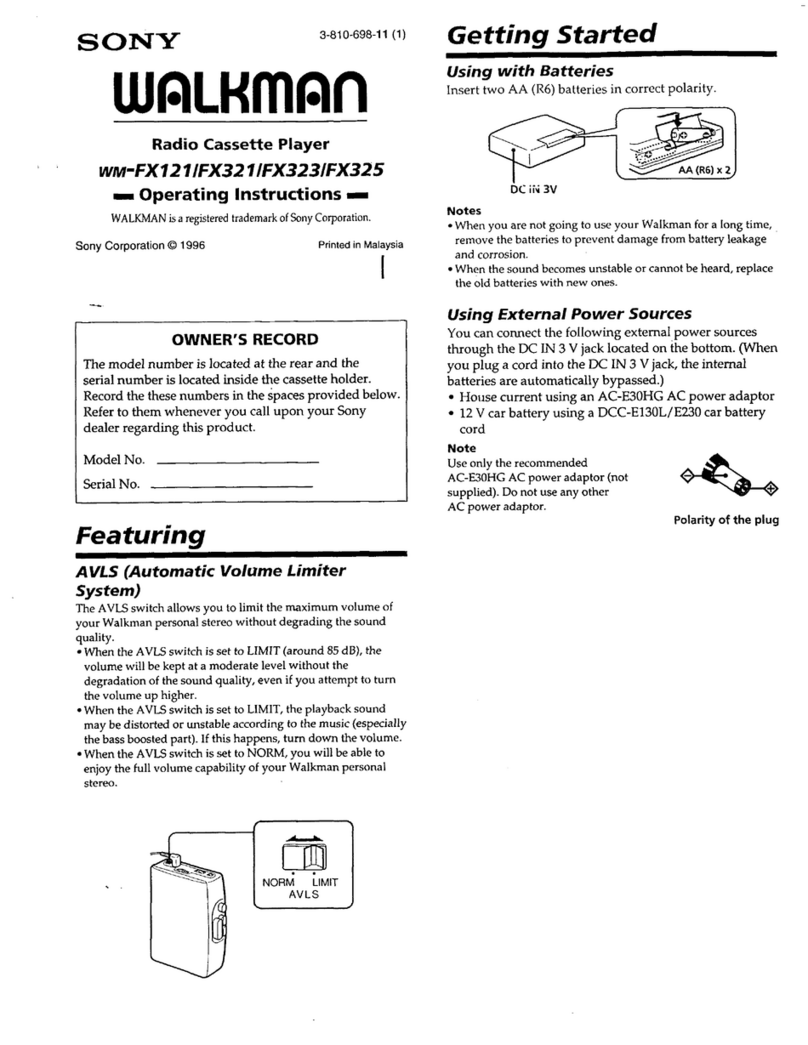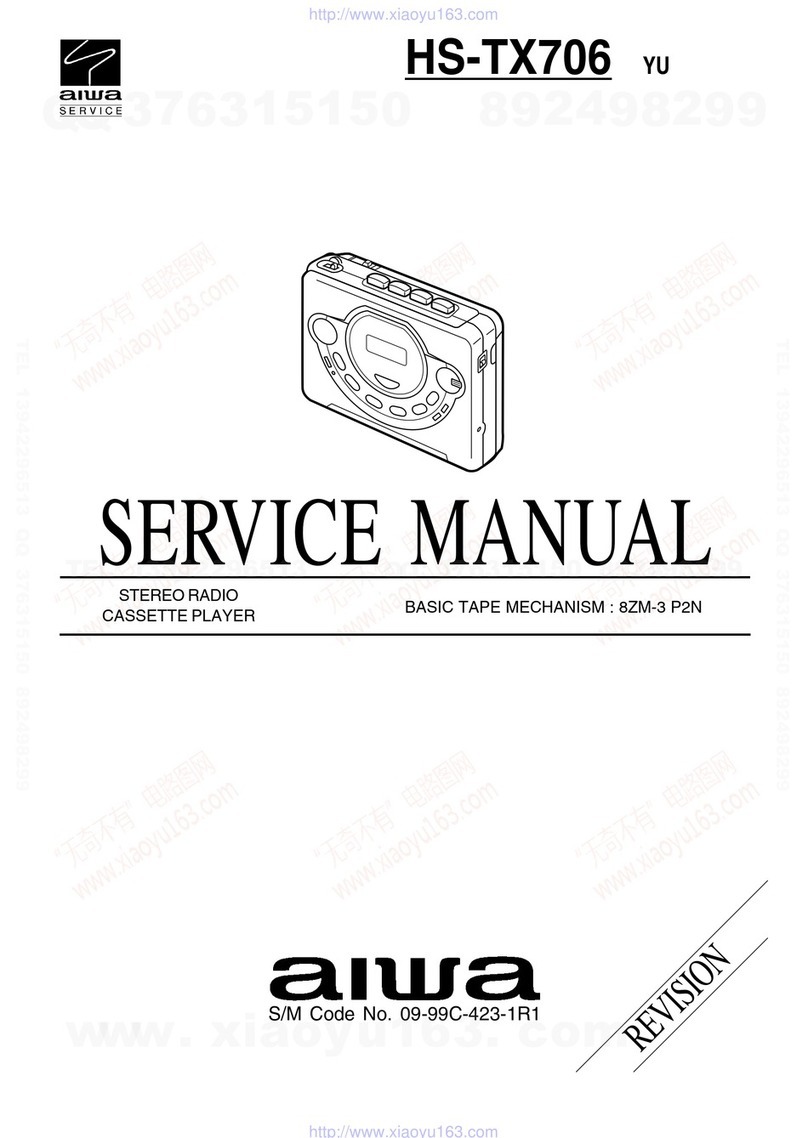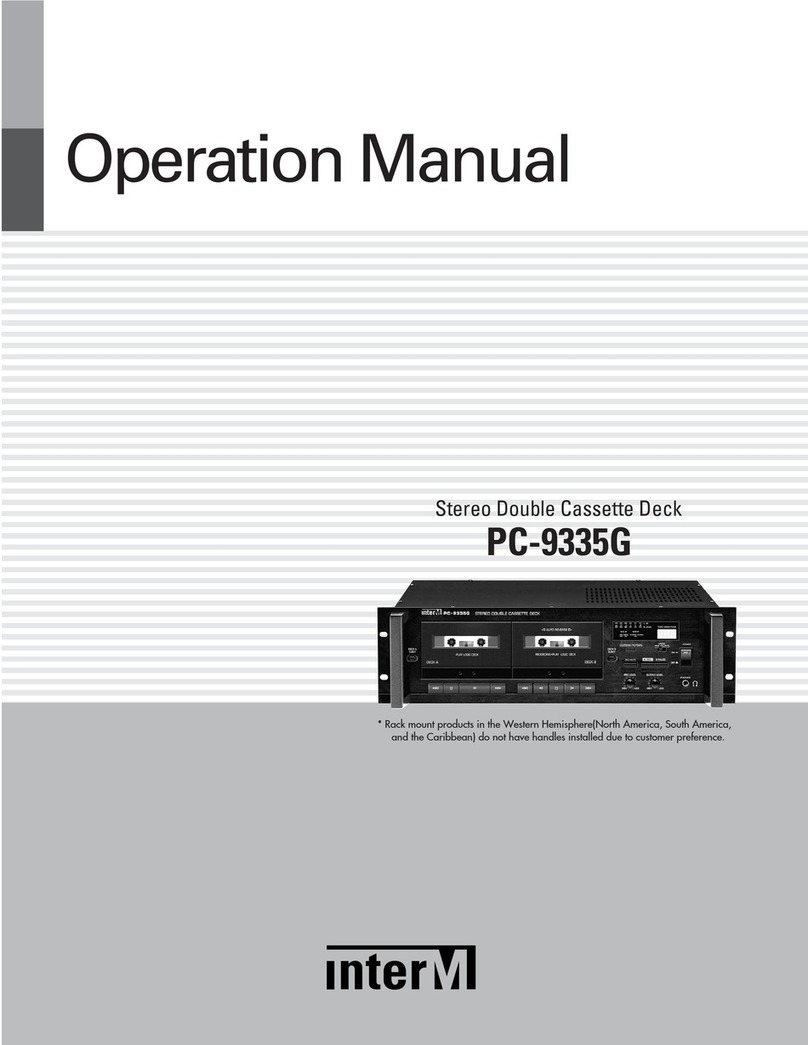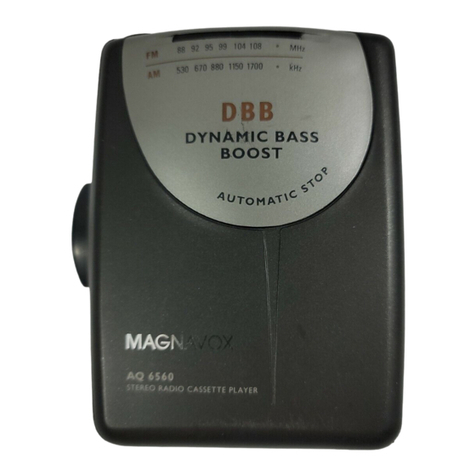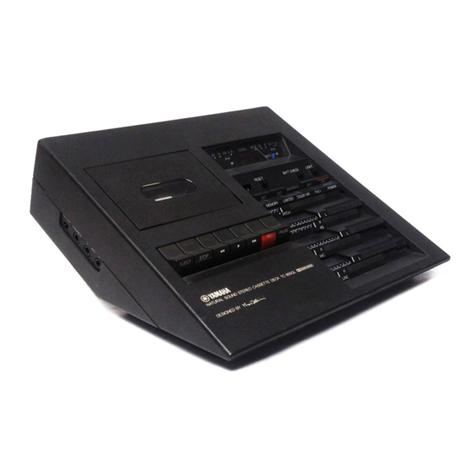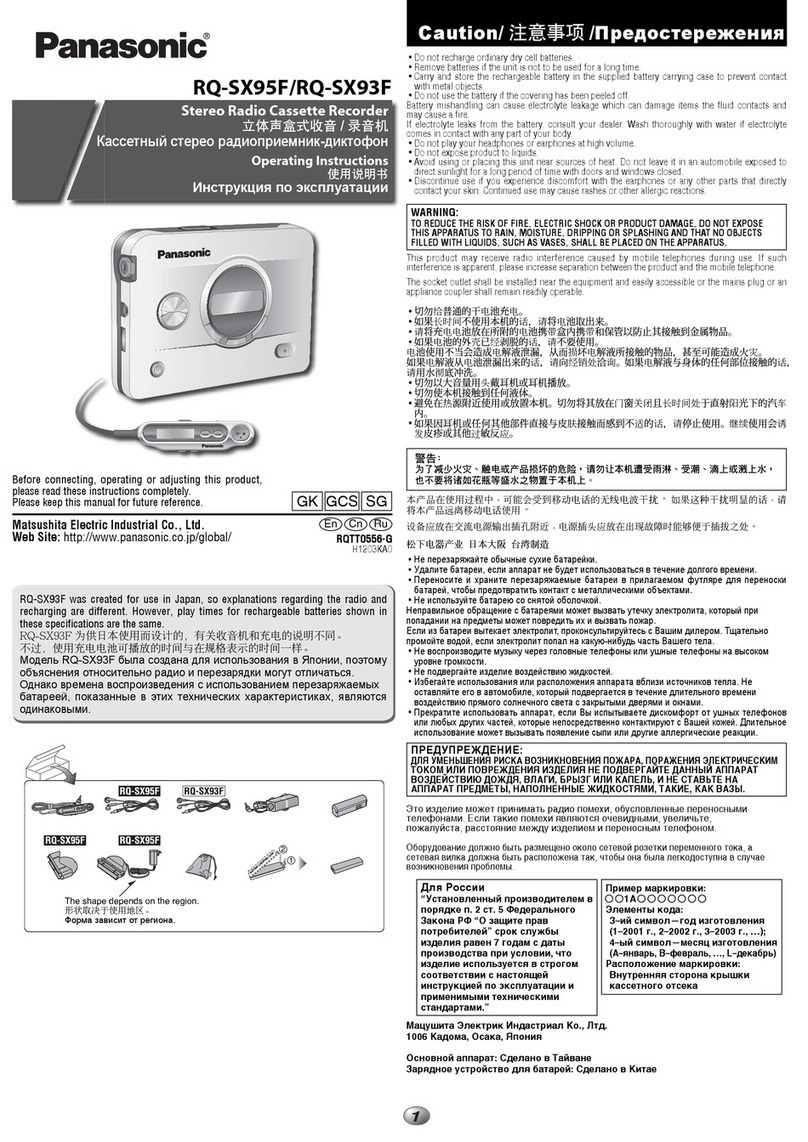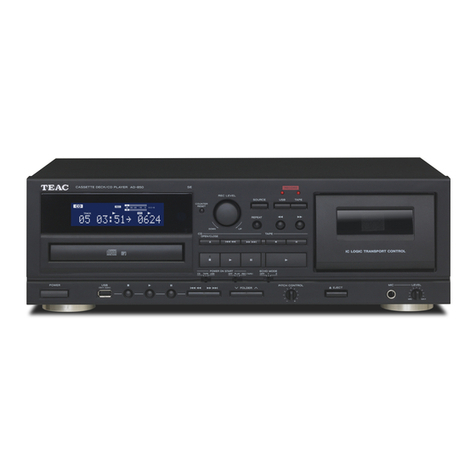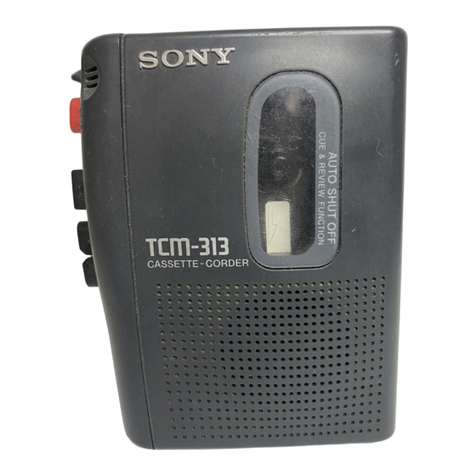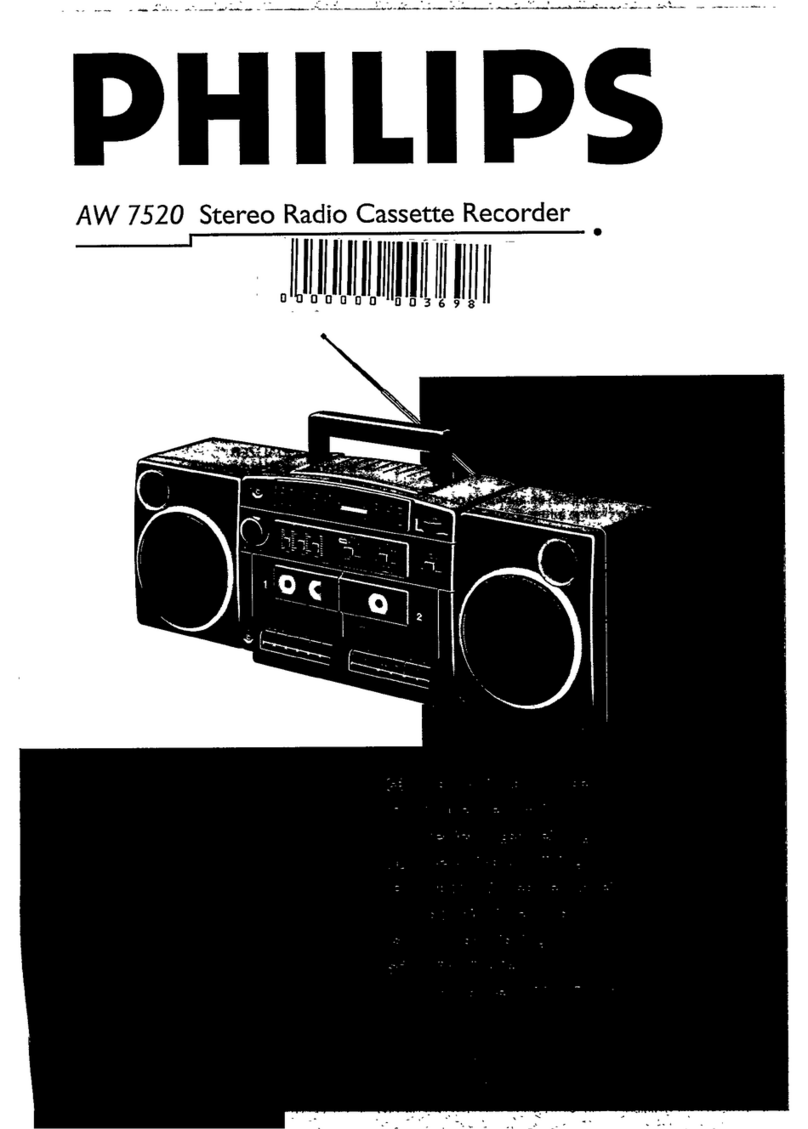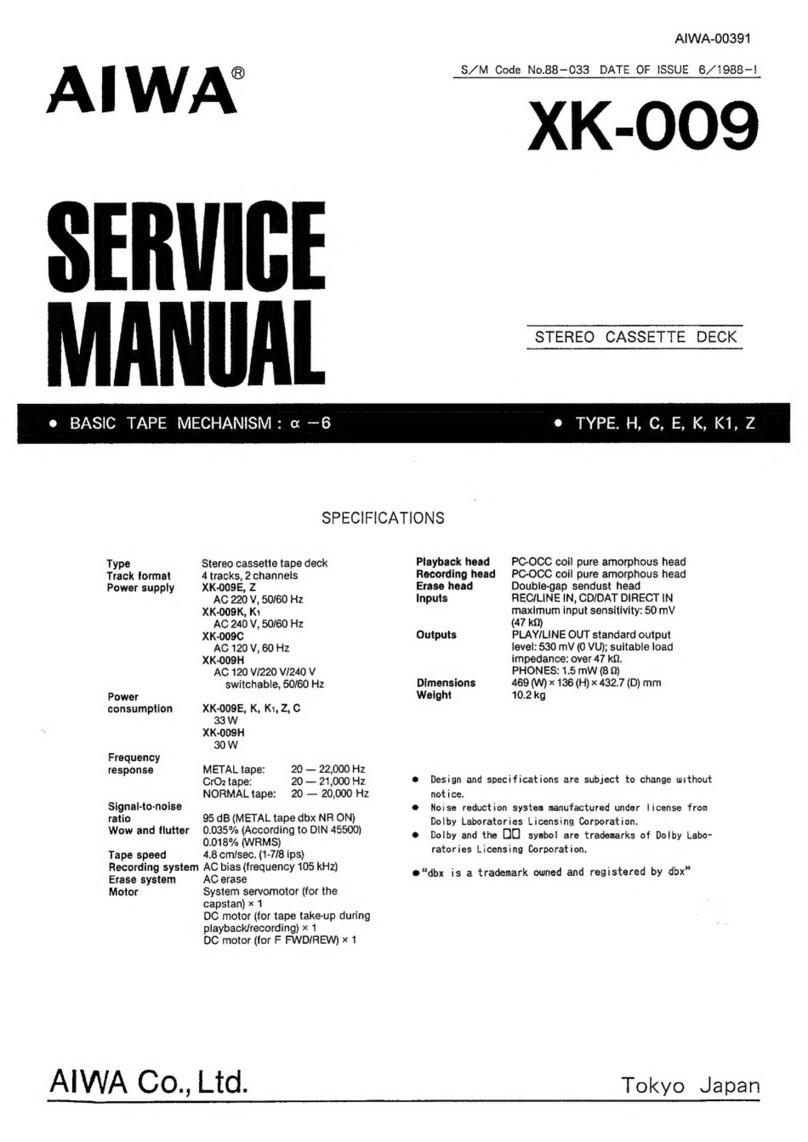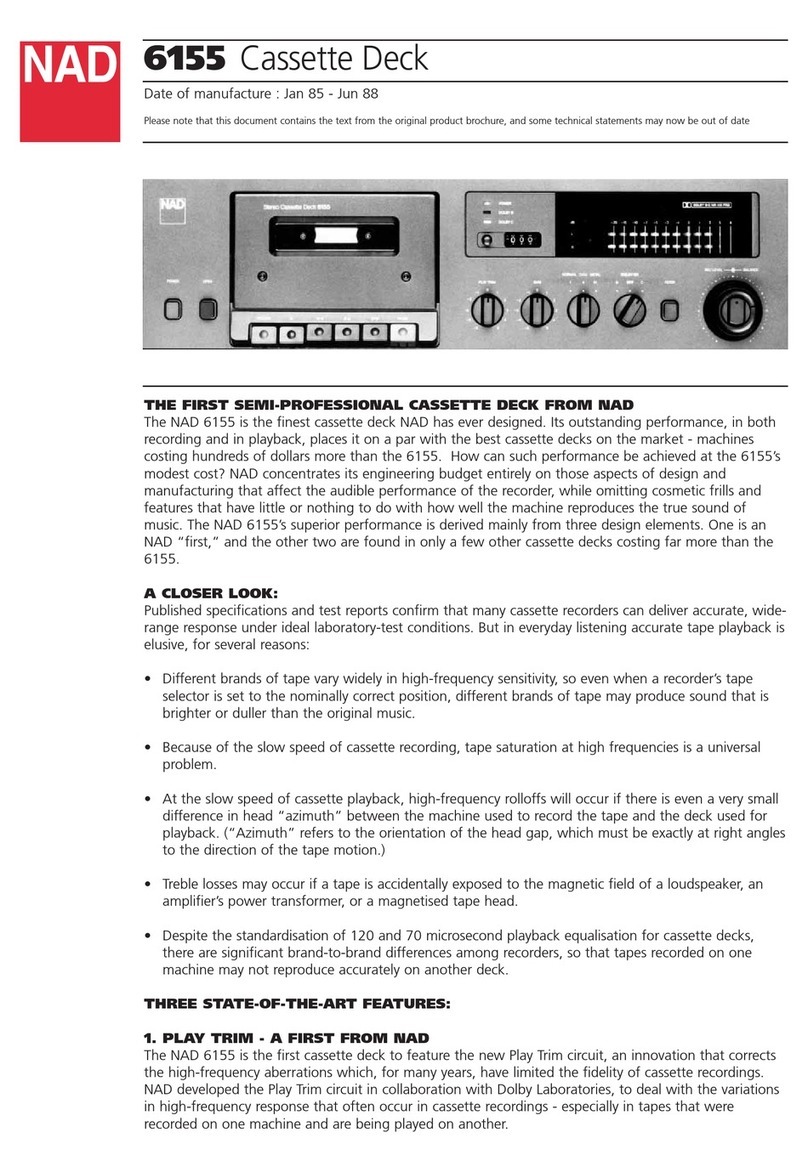GLOBAL RECORDINGS MESSENGER-II User manual

MESSENGER-II
HAND-WIND CASSETTE PLAYER
SERVICE MANUAL
GLOBAL RECORDINGS NETWORK AUSTRALIA
Locked Bag 9 19
Castle Hill NSW 1765
AUSTRALIA
Email: [email protected]
Phone: +61 2 9899 2211
Fax: +61 2 9899 26 2
(A.C.N 26 33) Revised June 2 4

MESSENGER-II HAND-WIND CASSETTE PLAYER SERVICE MANUAL
INTRODUCTION
Language Recordings has produced the Messenger-II player because of the worldwide demand from
missions and churches for a compact, reliable cassette player that is not dependent on batteries or other
costly power sources.
The purpose of this service manual is to provide the necessary technical information, parts lists and
drawings for those who will be doing in-service repairs and maintenance to these players.
The technical descriptions have been kept as simple as possible and have been prepared with the non-
technical person in mind. As well as providing this Service Manual and any necessary spare parts, we
believe in the concept that “prevention is better than cure”, and we strongly recommend that where any
“Messenger-II” players are put into use that those using them should be given careful instructions in the
basic care and maintenance of those players.
(See ‘Care of Cassette Players’ on operating instructions leaflet).
The Messenger-II Player is produced in two different ‘formats’:
a. Player Designation: LRI- 3M = Plain Mabuchi i.e. Mabuchi Generator.
b. “ “ LRI- 3MP = Mabuchi with Power i.e. Mabuchi Generator plus Mains Power Transformer.
TABLE OF CONTENTS
Introduction.................................................................................. 1
Equipment & Specifications for Testing...................................... 2
Trouble Shooting Procedure........................................................ 3-5
How to Order Parts...................................................................... 6
Messenger-II Disassembly and Servicing.................................... 7-8
Messenger-II Player Assemblies - Drawing M- 2....................... 9
Case Assembly - Parts List and Drawing M- 3........................... 1 -11
Generator Assembly - Parts List and Drawing M- 4................... 12-13
Mechanism Assembly - Parts List and Drawing M- 5................ 14-15
A.C. Power Supply Assembly - Parts List and Drawing M- 6.... 16
Circuit Board Assembly - Parts List and Drawing M- 7............. 17
Circuit Board Overlay and Schematic Diagram M-1 ................. 18
Circuit Diagram M- 9.................................................................. 19
Generator and Power Wiring Diagram......................................... 2 -21
Replacing Generator leads, helpful tips........................................ 22-23
Trouble-Shooting Guide............................................................... 24
EQUIPMENT & SPECIFICATIONS FOR TESTING
NECESSARY EQUIPMENT
1.Basic
a. Multimeter - With approx. 2-3v A.C. range, full deflection. e.g. A meter with a sensitivity of at least
1 k/volt
b. Dummy Load - 7.5 ohms resistance and lead; or external speaker(8ohms).
c. D.C. Power Test Lead - To allow measurement of voltage & current. (Ref. Figure 1&3)
d. Test Tapes - 6.3 KHz at 15dB for Head Azimuth.
- 1 KHz at OdB for current consumption & output level.
e. 6v regulated power supply or 6v battery pack, (Fig. 1&3)
Note: Language Recordings is prepared to supply any of the above equipment to those who do not have
ready access to such.

2. Optional
a. Oscilloscope )
b. Frequency counter ) desirable for major servicing
c. Cassette Torque Meter ) centres.
d. Signal Generator - helpful for trouble shooting of circuit board.
MEASUREMENTS & ALIGNMENT
1. Supply voltage for testing: 6v +/- .2v Measure the voltage across supply used for testing, with 1Khz
tape playing at full volume into dummy load (fitted to external speaker socket). If the voltage is outside
of tolerance, incorrect readings may be obtained for other tests.
2. Generator Output Voltage: Must be over 4.5v
Measure voltage across the Generator Leads at the Circuit Board while playing 1 KHz tape at full volume
into dummy load, and cranking at normal speed.
3. Playback Head Azimuth Adjustment:
(NOTE. A dot on the Name Plate Label, C12 indicates the location of a hole in the Front Case provided for
the insertion of a small screwdriver to adjust the head alignment screw).
After cleaning and demagnetising playback head, adjust the volume control to maximum and use 6.3KHz
-15dB test tape to adjust the head azimuth. Adjust output to maximum reading and when satisfied place
some contact cement on srew heads to prevent vibration moving them.
(Beware of false harmonic readings) For this reading the oscilloscope is adjusted to the following settings –
Sweep range 1 -1K; Vertical gain 1/1 . If an oscilloscope is unavailable a multimeter may be used.
4. Motor Speed Adjustment
Use the 1KHz -11dB tape to adjust the speed (1 -1 1 Hz) on the digital frequency counter, or digital
multimeter with frequency range. The adjustment is made by inserting a small screwdriver through the small
hole in the top of the drive motor and turning the adjusting screw.
5. Output Level Adjustment
Using the 1KHz -11dB tape, check the output level. It should measure about 3.6 volts peak to peak. If
necessary adjust the variable resistor VR2 to achieve the desired output. Too high a level will cause
distortion(clipping of the waveform).
If an oscilloscope is not available use the following procedure.
i.) Using an extension speaker plug and a piece of wire, fit a dummy load of 8.2 ohms across the plug. (See
Fig. 2)
ii.) Attach an AC volt meter with approximately 5-1 volts full scale deflection.
iii.) With a 1KHz -11dB tape at maximum volumethe output should be 1.3 volts RMS. (Equal to 3.6 volts
peak to peak.)
iv.) The same variable resistor adjustment VR2 can be used to obtain the right voltage reading.
6. Current consumption:19 -27 mA at 6v.
Using the 1KHz -11dB tape and volume at minimum the current should be approximately 13 mA, played
into an 8.2 ohm dummy load plugged into the external speaker socket. With the volume at maximum the
current should be approximately 2 mA. If current is excessively high check for free movement of
mechanical parts, especially the capstan flyhweel assembly and the pinch roller.
7.Wow and Flutter: Less than 2% Play 1 KHz tape and listen for clear tone, or observe wave stability on
oscilloscope. Set up the Oscilloscope as for Azimuth Alignment and check stability at the right hand side of
the screen. Variation should not exceed 2% of screen width. Rapid fluctuation usually indicates a bent
capstan, while slower fluctuation (about 1 second duration) would indicate a worn pinch roller or other drive
component.
8.Take up Torque: 35-6 gm/cm Measured with cassette torque meter. Too much torque tends to raise
current consumption of the machine. Low torque can cause tape to wrap around capstan.

TROUBLESHOOTING PROCEDURE
INTRODUCTION
The key to efficient, effective repair is a logical approach to troubleshooting and diagnosing the
fault. The first step in any troubleshooting process is to examine carefully all the symtoms of the
fault. This investigation should guide us to a limited range of possible problem areas in the
machine. At the same time we need to eliminate areas that are functioning correctly. This enables us
to focus attention on a particular part of the machine and should help us to locate and rectify the
fault as quickly as possible.
This first step could be called the “mapping” step since the effect is to map out the problem areas
for further investigation. It is important to do a complete “mapping” of the machine before
proceeding to analyse each of the areas which may have caused the trouble. Premature assessment
of a fault, without logical and thorough investigation, can result in unnecessary removal of parts for
observation, needless replacement of good parts, tampering with adjustments that should be left
alone, and, in general, wasting a lot of valuable time.
The service manual is an essential part of the “troubleshooter’s” equipment. The information
provided in the drawings, circuit diagrams, block diagrams, parts list, etc. will help us to quickly
isolate a fault to a single area of the machine.
The novice or layman in the area of electronic repair should not be overawed by the apparent
complexity of the service manual. The manual has been prepared with the non-expert in mind and
we trust that the instructions given will be clear enough for all to follow. Regular experience in
maintenance and repair of the Messenger-II will soon help the novice to become familiar with the
parts of the machine most likely to give problems. Those who only carry out repairs on odd
occasion s or in emergencies need to take special care and be aware that hasty action or diagnosis of
the problems may lead to a lot more expense and time expended than is really necessary.
TROUBLESHOOTING PROCEDURE
The three major areas of the troubleshooting map that need to be considered when working on a
Messenger-II player are:-
1. The generator assembly
2. The cassette mechanism
3. The amplifier
1. The Generator Assembly
The generator assembly is probably the most straight forward mechanism within the Messenger-II
player, consisting of a drive train of gears and pulleys. However, it is subject to more wear than any
other part of the machine and usually requires a greater amount of maintenance.
2. The Cassette Mechanism
The cassette mechanism can be further broken down into smaller areas, e.g. Motor, keyboard, fast
forward mechanism etc. and each of these can be examined as separate entities. Keep in mind that a
machine takes a source of motion and processes it so as to fulfill some useful purpose. For example,
the motor provides the motion necessary to move the tape within the cassette case. It does this via a
belt, pulleys and wheels. As another example, a finger can be the source of movement. It can be
used to depress a key which then directs the motion from the motor to drive the tape forward, into
rewind, play, or if the stop key is depressed, to halt all tape motion.
3. The Amplifier
When considring the amplifie we also need to take into account the playback head, volume control,

extension speaker socket and speaker. The magnetically encoded signal on the tape produces a very
weak signal in the playback head as it passes over it. This is then amplified for the purpose of
driving the speaker.
SAMPLE PROCEDURE - 1
Symptoms of faulty player. The Messenger-II player will not operate at the correct speed when
powered by its own generator.
Preliminary Diagnosis
At first consideration you cannot help but be equally suspicious of the three main areas -
1. The generator belt may have slackened with age or the generator itself may have failed.
2. The cassette mechanism could have a faulty motor, a jammed pinch roller etc.
3. The amplifier could have a fault which causes it to drain an excess amount of current from the
generator.
You need to eliminate as many areas of the “map” as you can and concentrate on the one area at
fault.
Procedure for investigation
1. Plug in an extenal 6v D.C. Source. If the player now works correctly and does not draw excessive
current, then the generator most likely is at fault. Conversely, if the player still does not work
then the generator is probably not at fault and the fault lies in one of the two other areas.
2. Check the motor by disconnecting it from the circuit board and connecting it to a seperate 6v
D.C. Power supply. If motor and mechanism operate, they are probably not at fault. If motor
speed appears to be slow, investigate current consumption of motor or replace motor.
3. Investigate current consumption of circuit board, or replace circuit board.
By following this type of procedure you are successfully reducing the areas in which you need to
look for the fault and by carrying out tests like these on each of the possible areas of failure you will
be able to locate and identify the offending component.
SAMPLE PROCEDURE - 2
Symptoms of Faulty Player: No sound.
Preliminary Diagnosis
The fault is probably in the amplifier but, before proceding to investigate this, do the following
quick checks :-
1. Check the cassette tape. Is it broken, jammed, or simply stopped at its end?
2. Check the cassette mechanism. In play mode is the mechanism working correctly and pulling the
tape across the playback head?
If both of the above checks show that the cassette and mechanism are satisfactory we can then
move on to investigate the amplifier chain. Note that there are 3 main sections of this:-
a) The speaker and extension speaker socket.

b) The amplifier section of circuit board.
c) The playback head.
(refer also to block diagram, fig. 5, p.4)
Procedure for Investigation
1. Plug an extension speaker into the extension speaker socket. This effectively by-passes the player’s own
speaker and introduces a new one. If the extension speaker works, then either the speaker in the player is
faulty, or else there is possibly a fault in the switch which is located within the extension speaker socket
or a broken wire.
2. If Procedure 1 produces no result, move on to the amplifier board. First, check this visually to see if there
are any obvious broken or loose connections. These should be resoldered. If no sound results, place
finger on both connections of the lead from the head where it 3 joins the circuit board and turn volume
up. If no noise is heard the circuit board is possibly at fault and should be replaced.
3. If Procedure 2 produces noise, proceed to check the playback head and its connections. Use a mutimeter
to check the wires from the head to the amplifier board. if the connections are satisfactory the head
should be replaced.
Messenger-II PLAYER PARTS LIST
HOW TO ORDER PARTS
1.INTRODUCTION
a. SERIAL NUMBER: Example of a serial No. 9-89 M DCEC 22
The serial number, as found both inside and outside the player, is composed of three main parts.
i. Date of manufacture ’ 9-89' Letter- ‘M’ Designates what generator type is used, and whether
A.C. power supply is included, e.g. M= Mabuchi, MP= Mabuchi with A.C. Power.
ii. Batch Letters - These designate the revision batches of the main assemblies in the machine.
These are essential for supply of correct repalcement parts. They are stamped on each assembly as
indicated on the parts drawings and are listed in the serial number in the following order -
Case Assembly - Generator Assembly - Mechanism Assembly - Circuit Board Assembly.
iii. Machine No. - Identifies the particular machine.
e.g. Model Letters Batch Letters Machine No.
M D C E C 22
b.PARTS NUMBERS: Example of a Part No. 5G217
These consist of -
i. A prefix letter ’5G’ which indicates which assembly the part is from, and thereby on which
drawing it is shown.
ii. A single digit numeral to indicate major part revisions or alternative types. These are listed
underneath each other in the parts list, and must be determined when ordering parts. An ‘x’
indicates alternative types of the part, and that appropriate type no. must be selected from the parts
list when ordering. (The ‘5’ is a computer prefix)
e.g. Gx17 refers to G117 or G217 in parts list.
iii. A two digit numeral to identify the particular part in the assembly.
Assembly Letter Type No. Part No.
e.g. Part No. B1 4 B 1 4

2. HOW TO ORDER PARTS.
Please identify the part from Parts Drawings, and write both its Part No. (including appropriate
type), and Name plus Quantity.
Also, please include complete Serial Number/s of the player/s for which the parts are required. If the
parts are for spares for a a quantity of players, then the most common Model Letters and Batch
Letters would be sufficient.
Sample Order
QUANTITY PART NO. NAME SERIAL NO.
5 5-G1 4 Gen. Belt MP-DCEC- 1548
If possible, please try to explain what is the fault in worn parts and what may have caused them to
fail. Also describe the symptoms of the fault and the in-service age of the player. This will greatly
help us to develop a better player for the mutual benefit of all users of these players.
MESSENGER-II DISASSEMBLY AND SERVICING
Please refer to Drg. M- 2
To Open Case (See also drg. M- 3)
a) Unscrew the Crank arm Assembly G15 by raising the handle and turning it anticlockwise (opposite
direction to the arrow). This may require a sharp tap on the winding arm to begin the unwinding.
b) Remove 5 screws (4 Case Screws C114 and one Handle Screw C115) in back of case. Carefully pull the
two halves fo the case apart while keeping them parallel to each other. There may be some resistance at
first, until the Crank Shaft G1 9 is pulled through the Upper Crank Bearing C1 6, but pull the halves
apart carefully as the generator wires may be broken. It is now possible to unplug socket connector G141
on Mabuchi player without power, and socket connector p112 on Mabuchi player with power, from the
circuit board and so separate the two halves of the player case. Note: Be careful not to pull on the wires.
Grasp the socket connector between thumb and forefinger from above and gently ease out with the help
of a small screw driver.
2.To Remove Mechanism 5-M2 and Circuit Board Assemblies.
( See also drg. M- 3, M- 5)
a) Buttons (keys) M1 2, M1 3, M1 4, M1 5 must be in OFF position.
b) Desolder the two wires from the Speaker C1 3, and unplug PIN connector.
c) Unscrew the Spacer Post C112, Motor Plate Screw S12 and the Mechanism Screw C116 located near the
Clutch Assembly on the mechanism, then lift the mechanism from the Front Case C1 1.
3. Circuit Board Assembly B6 . (See also Drg. M-97)
a. To Remove and Disassemle
i. Remove Circuit Board Screw M1 6 and Washer M1 7. Loosen the Side Plate Screws M1 8 and then
move the assembly sideways from the mechanism.
ii. If the circuit board is to be replaced, desolder all wires from the circuit board, noting their colour and
position on the board. Remove the two D.C. Socket Screws S 2 and the Dress Ring B2 7 from the
External speaker Socket B2 6 and them remove the Side Plate B2 8. Remove the Volume Control Screw
S 1 and Wheel B2 2.
b. To Reassemble and Replace
i. Replace Volume Control Wheel B2 2 and Screw S 1
ii. Attach Side Plate B2 8 with Screws S 2 and Dress Ring B2 7.
iii. Position the Circuit Board Assembly correctly on the mechanism, by pushing the slots of the Side Plate
firmly against the Side Plate Screws M1 8 before tightening them. Then replace Circuit Board Screw
M1 6 and Washer M1 7.
4. Servicing the Mechanism M1 (See also drg. M- 5)
a) With the mechanism removed from the case, all pars of it are easily accessible for adjustment and
replacement of parts.

b) Before removing any part, note it’s position and method of retention. Also observe other associated parts
which may be disturbed during removal, such as springs and washers. Very carefully remove the small
components, such as ‘E’ clips, which may be easily lost.
c) If the Flywheel is removed, care should be taken that its capstan shaft is not knocked in any way
during handling. Any damage to the capstan shaft would cause the player to produce a rapidly
wavering sound. After replacing the Flywheel, or removing the Flywheel Retainer Plate, its end-
play should be checked. This should be . 5" - . 1 " ( .13 - .25 mm). If this is incorrect, it
should be adjusted as follows:-
i. Make certain the 3 screws securing the Flywheel Retainer Plate are tight. N.B. Do not
overtighten any screws on the mechanism.
ii. Using a screwdriver, adjust the End Thrust Bearing in the Retainer Plate until there is a
slight gap between the bearing and the end of the shaft of the Flywheel.
iii.Remove the Drive Belt M12 from the Motor Pulley. Move the Flywheel up and down to
feel the end-play, while slowly screwing the Thrust Bearing in, until the end-play just
disappears. Then unscrew the Bearing 1 turn and check that the Flywheel has the correct
amount of end-play and spins freely.
iv. Replace the drive belt, and seal the Thrust Bearing in place with contact cement.
d) To replace the Playback Head M114, unsolder the wires, remove only the screw nearest the pinch
roller. Then move the Head sideways out from under the other screw. If the Playback Head is
replaced or disturbed, its azimuth angle will need to be adjusted to ensure correct playback of all
frequencies. This is achieved by adjusting the spring loaded mounting screw while playing a 6.3
KHz at -15dB alignment tape, and adjusting for maximum signal level (please refer to testing
procedures). If a special alignment tape is not available, a good music passage on a commercially
produced tape may do. Listen for sharpness of high frequency parts of the music. Finally, seal the
alignment screw which contact cement.
Azimuth Alignment tapes may be obtained from Language Recordings Inc., Australia.
e) Before reassembling the machine, check that the Leaf Switch operates properly when the Play
Button (Key) is depressed. Check that all moving parts of the mechanism are operating
satisfactorily, and check that all springs & ‘E’ clips are in place and that screws are not loose.
N.B. Do not over-tighten any screws on the mechanism.
5. Generator Assembly G1
Servicing of the Generator Assembly G1 other than replacing the Belt, is best carried out by
replacing any faulty sub-assembly with a new unit (see parts list). Individual parts may be replaced
if it is determined that only one part is at fault.
6. Closing Case
When closing the case check carefully that the lead from the Generator
to the circuit board is not touching any moving parts.
7. Re-checking Player Performance.
After repairs or adjustments are completed, re-check the relevant specifications of the player using
the test procedures listed under “Equipment & Specifications for Testing”. Remove all dirt and dust
from the player before closing the case and clean head, capstan and pinch roller as described in the
Operating Instructions.


Messenger-II PLAYER PARTS LIST
CASE ASSEMBLY - No C100
NO. PART DESCRIPTION
C1 1 Front Case Moulded ABS, includes C1 8 - C111.
C1 2 Back Case Moulded ABS.
C1 3 Speaker 3" dia, 8 ohms, .5 watt, Ferrite or Alnico type.
C1 4 Speaker Clamps x2 Pressed steel, 22g
C1 6 Upper Crank Bearing Acetal Bearing
C1 7 Cassette Well Cover Moulded polycarbonate.
C1 8 Mounting Post ‘A’ x 2 1/4" x .925" machine brass.
C1 9 Mounting Post ‘B’ 1/4" x 1.85 " machined brass.
C11 Mounting Post ‘C’ 1/4" x 2.283" machined brass.
C111 Mounting Post ‘D’ 1/4" x2.6 " machined brass.
C112 Spacer Post 1/4"AF x . 948" Hex-steel, machined
C118 Blanking Plate Moulded Nylon
C119 Label-Cassette Cover “Press STOP button before removing cassette”/
C12 Label-Name Plate Messenger-II: LRI- 2
C121 Label-Model M LRI- 2- Mabuchi Generator, D.C. only.
C123 Label-Model MP LRI- 3MP - Mabuchi Generator A.C. power input.
C125 Reflective Sticker 24mm dia, orange, self adhesive.
C126 Label - Serial No. (2 off)
C129 Cassette Well Cover Locks Moulded plastic
S12 Motor Post Screw M3 x .5 x 6mm, machine screw
S15 Case Screws (4 off) M3 x .5 x 16mm, machine screw
S16 Speaker Clamps screws x2 M3 x 6 self tapping screw
S16 Mechanism Screw M3 x 6 self tapping screw
S17 Handle Screw (1 off) M3 x 1 self tapping screw
S17 Generator Assembly screws x2 M3 x 1 self tapping screw


Messenger-II PARTS LIST
GENERATOR ASSEMBLIES - NO G100
NO. PART DESCRIPTION
G1 2 Pulley Wheel Moulded acetal
G1 4 Generator Belt 2.2mm sq. section, polyurethane.
G1 6 Pulley Wheel Shaft Machined steel, 5mm dia.
G1 7 Gear Plate Pressed Steel, galv., 2 g
G1 8 Gear Wheel Moulded Nylon
G1 9 Crank Shaft Machined Steel, 1/4 dai.
G111 Roll Pin 1/16" x 1/2" steel pin.
G112 Split Pin 1.6 x 12mm steel, split pin
G117 Generator Mabuchi RF—37 C 1537
G118 Generator Plate Pressed steel, galv, 2 g
G12 Generator Pulley 12mm dia. x 7mm wide (M)
G121 Crank Arm Pin 3/32" dia. x 12mm, tubular alum. rivet.
G122 Crank Drive Stud Machined steel
G123 Crank Arm Moulded Glass filled nylon
G124 Crank Knob Moulded nylon
G125 Crank Hub Moulded glass filled nylon
G126 Crank Knob Pin Machined steel
G132 Pulley Shaft Nut 1/8" B.S.W., hex, steel.
G141 Generator Socket Connector Utilux H954 -3 KK connector.
G143 Gear Plate
G144 Gear Adjusting Plate
G145 Gear Adj. Plate Rivet
G146 Gear Adj. Plate Root Nut
G227 Lower Crank Bearing Moulded acetal .25 " I.D.
P1 6 Cable Tie 15 mm Moulded plastic
P114 Terminal Clip (large)
S 6 Generator Plate Screws x 2 M2.6 x 4 Taptite Screws
S12 Gear Adjusting Plate Screw. M3 x .5 x 6mm machine screw
S14 Generator Screws x 2 M3 x .5 x 3.5mm machine screws
W 3 Generator Screw Washer M3 internal shake proof washer
W 3 Pulley Shaft Washer M3 internal shakeproof (star) washer
W 6 Gear Adj. Plate Washer 1/8 x 3/8 washer
W 7 Crank Thrust Washer 5/32” x 3/8” x 21g flat washer
W 8 Pulley Wheel Washer M1 x 5 x .5 steel washer
W 9 Crank Bearing Washer 1/4" x 1/2" x 24g flat washer
W1 Lower crank Bearing clamp Pressed spring steel
SUB ASSEMBLIES
G11 Crank Shaft Assembly Comprises part nos. G1 9, G111
G116 Generator Lead Assembly Comprises twin core wire, plus G141, 2 x P114
G138 Generator Assembly Comprises part nos. G117, G12 ,G116,P1 6
G142 Gear Plate Assembly Comprises part nos. G143, G146
G15 Crank Arm Assembly Comprises Part Nos. G121—G126, W 7


MECHANISM ASSEMBLY - No M200
NO. PART DESCRIPTION
5E 1 Reel cap circlip x 2 M1.5
5E 2 Brake plate guide pin circlip x 3 M2
5E 2 Pinch Roller frame post circlip M2
5E 3 Clutch swivil pin circlip M3
5E 3 Head base guide circlip x 3 M3
5M1 8 Motor screw sleeve (x3) Machined brass
5M11 Drive motor assembly
5M114 Playback head
5M115 Pinch roller assembly
5M117 Capstan flywheel assembly
5M12 Drive belt 75 x 1.2mm square section polyurethane
5M122 Leaf switch (x2)
5M127 Flywheel assembly
5M139 Pinch roller frame spring
5M143 Head base assembly
5M145 Head base spring
5M149 Azimuth alignment spring
5M153 Latch plate
5M154 Latch plate spring
5M161 Flywheel support plate
5M162 Flywheel thrust bearing
5M166 Brake plate assembly
5M168 Brake plate spring
5M17 Rewind motor assembly
5M172 Rewind motor plate
5M174 Rewind motor plate spring
5M174 Take-up Clutch spring
5M178 Cassette tension spring
5M193 Reel stand spring
5M194 Reel stand (1 piece) (x2)
5M195 Reel stand rubber (x2)
5M2 3 Motor Cushion (x3)
5M2 8 Deck Plate Assembly
5M238 Take-up clutch assembly
5P1 6 Cable Tie 1 mm
5S 3 Leaf switch screw (x2) M2x5 taptite screw
5S 8 Button frame screw (x3) M2.6x6 taptite screw
5S 8 Rewind Motor Plate screw (x2) M2.6x6 taptite screw
5S1 Playback head alignment screw M2x6 Philips machine screw
5S12 Circuit board screw M3x6 Philips machine screw
5S12 Flywheel supt. post screw (x3) M3x6 Philips machine screw
5S22 Side Plate screw (x2) M3x6 Philips taptite screw
5S23 Drive Motor screw (x3) M2.7x6 machine screw
5S24 Rewind motor screws (x2) M3x3.5 Philips machine screw
5W 1 Reel Stand Washer Polyslider M2.2x4x .3
5W 1 Flywheel Assembly Washer Polyslider M2.2x4x .3
5W 3 Circuit board washer M3 internal shakeproof washer

SUB-ASSEMBLIES
5M11 Drive Motor Assembly
5M1 9 Drive motor Mabuchi EG-51 D-6F2, 6v, 24 rpm
5M111 Drive motor pulley
5P1 6 Cable Tie 15 mm
5M115 Pinch Roller Assembly
5M136 Pinch roller M13 OD x 6.5 x 2.5 bore
5M137 Pinch roller axle M11.2 x 2.5
5M138 Pinch roller frame
5M13 Button frame assembly
5E 2 Button shaft circlip M2 E-clip
5M1 2 Stop button (red)
5M1 3 Play button (green)
5M1 4 Forward button (yellow)
5M1 5 Rewind button (blue)
5M131 Button frame Pressed steel
5M132 Button frame shaft
5M135 Button blade (x4) Pressed steel
5M175 Button spring (f) (x2)
5M176 Button spring (g) (x2)
5M143 Head Base Assembly
5M144 Head Base
5M146 Replay head stud
5M15 Azimuth alignment stud
5M151 Cable Tie stud
5M213 Pinch Roller Frame post
5M157 Capstan Bearing Assembly
5M158 Capstan bearing housing
5M159 Capstan bearings (x2)
5M166 Brake Plate Assembly
5M167 Brake plate
5M169 Brake Plate guide pin
5M17 Rewind Motor Assembly
5G117 Generator/Rewind motor Mabuchi RF-37 -1537
5M186 Rewind Motor Pulley
5P1 6 Cable Tie 15 mm
5M2 8 Deck Plate Assembly
5M155 Latch plate posts (x2)
5M157 Capstan Bearing Assembly
5M163 Flywheel support post (x3)
5M169 Brake plate guide pins (x3)
5M192 Reel Shaft Assembly (x2)
5M2 9 Deck Plate
5M21 Cassette Support stud (x2)
5M211 Cassette location pin (x2)
5M212 Head Bases Guide Pin (x3)
5M214 Cct board support post
5M256 Clutch swivil pin


MESSENGER PLAYER PARTS LIST
A.C. POWER SUPPLY ASSEMBLY NO. P1
No. PART DESCRIPTION
5P1 1 Transformer 11 /24v, 6 Hz: 7v x 2, 25 mA
5P1 2 A.C. Socket Hosiden type No. HSC 438
5P1 3 A.C. Socket back cover Hosiden type No. HSC 438- 3- 1
5P1 4 Selector plate Moulded glass filled nylon
5P1 7 Cable Tie x3
5P1 8 A.C. Power cord
5P1 9 Loom sleeve M8 O.D. X 2 mm PVC tubing
5P11 Cable insulation sleeve Cable tie with screw hole
5P112 Pin connector 33 3-1 8 Adilam
5P113 Terminal clip (small) 34 -113 Adilam
5P114 Terminal clip (large) 34 -111 Adilam

CIRCUIT BOARD ASSEMBLIES B601 & B602
5B601 Circuit Board Assembly (plain)
5B6 Circuit Board ex supplier
5B2 2 Volume Control wheel
5B2 8 Side plate
5B213 Pin connector (3 pin)
5B214 Polarised Header
5S 1 Volume Control screw M1.7 x 5 machine screw
5B602 Circuit Board Assembly (power)
5B6 1 Circuit Board Assembly (plain)
5B218 Pin connector (4 pin)
5B215 Voltage Regulator
5B216 Regulator diode
5B217 Capacitor 1 uF 16V
5B219 Side Plate Assembly (plain) 5B220 Side Plate Assembly (power)
5B6 1 Cct brd assmy plain 5B6 2 Side Plate Assembly power
5B2 7 Dress ring 5B2 7 Dress Ring
5B2 8 Side Plate 5B2 8 Side Plate

Note: Power and non-power versions are identical, except that non-power models may have
components IC2, D3-D5,C19 omitted.

Table of contents


